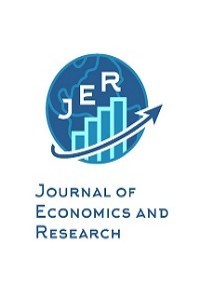LUCAS PARADOKSUNUN SEÇİLMİŞ GELİŞMEKTE OLAN ÜLKELER AÇISINDAN GEÇERLİLİĞİNİN ARAŞTIRILMASI
Sermaye Hareketleri, Lucas Paradoksu, Gelişmekte Olan Ülkeler, Doğrudan Yabancı Sermaye Yatırımları, Panel Veri Analizi
INVESTIGATING THE VALIDITY OF LUCAS PARADOX FOR SELECTED DEVELOPING COUNTRES
Capital Movements, Lucas Paradox, Developing Countries, Foreign Direct Investment, Panel Data Analysis,
___
- Alfaro, L.,Ozcan-Kalemli, S., &Volosovych, V. (2008). Whydoesn’tCapitalFlowfromRichtoPoorCountries? An EmpiricalInvestigation. TheReview of EconomicsandStatistics, 90(2) 347-368. Asteriou, D.&Hall, S.G. (2007). AppliedEconometrics A Modern Approach (Revised Edition). New York: PalgraveMacmillian.
- Aydemir, C., Arslan, İ. & Uncu, F. (2012). Doğrudan Yabancı Yatırımların Dünya’daki ve Türkiye’deki Gelişimi.Kocaeli Üniversitesi Sosyal Bilimler Enstitüsü Dergisi, 23, 69-104.
- Azémar, C. &Desbordes, R. (2013). Has TheLucasParadoxbeenfullyexplained?.EconomicsLetters, 121(2), 183-187.
- Bal, H.& Akça, E. E. (2016). Doğrudan Yabancı Sermaye Yatırımlarının Belirleyicileri: Seçilmiş Doğu Asya ve Pasifik Ülkelerinden Ampirik Bulgular. Sosyoekonomi, 24(30), 91-111.
- Bal, H., Akça, E. E., Tekin, İ., &Laleh, M. M. (2019). Reexamination of LucasParadox:Gravity Model ApproachforBricsCountrıes. Manisa Celal Bayar Üniversitesi Sosyal Bilimler Dergisi, 17(2), 267-292.
- Baltagi, B.H. (2005). Econometric Analysis of Panel Data (3rd edition). Chichester, UK: John Wiley&Sons Ltd.
- Chakrabarti, A. (2001). TheDeterminants of Foreign Direct Investment: SensitivityAnalyses of Cross-Country Regressions. Kyklos, 54(1), 89-114.
- Clemens, M. A.&Williamson, J. G. (2000). Wheredid British ForeignCapitalGo? Fundamentals, Failures andtheLucasParadox: 1870-1913 (No. w8028). NationalBureau of EconomicResearch.
- Demiral, M., Bal, H., & Algan, N. (2015). Gelişmekte Olan Ülkeler Küresel Sermayeyi Çekme Konusunda Niçin Başarısız Olmaktadırlar? Balkan Ülkeleri için Lucas Paradoksunun Yeniden İncelenmesi. Çukurova Üniversitesi Sosyal Bilimler Enstitüsü Dergisi, 24(1), 13-30.
- Duce, M.&Espana, B. (2003). Definitions of Foreign Direct Investment(FDI): A MethodologicalNote. Mimeo, Banco de Espana.
- Fernandez-Arias, E. (1994). The New Wave of PrivateCapitalInflows: PushorPull?.World Bank International EconomicsDepartmentDebtand International Finance Division, PolicyResearchWorkingPaper, No: 1312.
- Franken, C. & Van Wijnbergen, S. (2010). PrivateCapitalFlowstoLowIncomeCountries: Country-SpecificEffectsandTheLucasParadox. TinbergenInstituteDiscussionPaper No. 2010-003/2.TinbergenInstitute, Amsterdam.
- Gedikli, A. (2011). Çok Uluslu Şirketler ve Doğrudan Yabancı Yatırımların Gelişmekte Olan Ülkelerin Kalkınması Üzerine Etkileri. Girişimcilik ve Kalkınma Dergisi, 6(1), 96-146.
- Greene, W. H. (2012). Econometric Analysis. Seventh Edition. PearsonNew Jersey: Education Limited, PrenticeHall.
- Gujarati, D. N. (2004). Basic Econometrics. Fourth Edition, McGrawHillCompanies, New York.
- Kar, M.&Tatlısöz, F. (2008). Türkiye’de Doğrudan Yabancı Sermaye Yatırımlarını Belirleyen Faktörlerin Ekonometrik Analizi.KMU İİBF Dergisi, 10(14).
- Keskinsoy, B. (2017). LucasParadox in TheLong Run. MPRA (MunichPersonalRePec Archive) Paper No. 78126, 1-24, https://mpra.ub.uni-muenchen.de/78126/1/MPRA_paper_78126.pdf(Erişim Tarihi: 05.08.2019).
- Krueger, A. O. (1968). FactorEndowmentsand ER CapitalIncomeDifferencesAmoungCountries, EconomicJournal, 78, 641- 659. LucasJr, R. E. (1988). On TheMechanics Of Economic Development. Journal of MonetaryEconomics, 22(1), 3-42.
- Lucas, R. E. (1990). WhyDoesn'tCapitalFlowFromRichToPoorCountries?.TheAmericanEconomicReview, 80(2), 92-96.
- Okada, K. (2013). TheInteractionEffects of Financial OpennessandInstitutions on International CapitalFlows. Journal of Macroeconomics, 35, 131-143.
- Onyeiwu, S.&Shrestha, H. (2004). Determinants of Foreign Direct Investment in Africa. Journal of DevelopingSocieties, 20(1-2), 89-106. Pazarlıoğlu, M. V.& Gürler, Ö. K. (2007). Telekomünikasyon Yatırımları ve Ekonomik Büyüme: Panel Veri Yaklaşımı. Finans Politik & Ekonomik Yorumlar, 44(508), 35-43.
- Qolbi, N.&Kurnia, A. S. (2015). Intra Asean-5 CapitalFlows: Do TheyRepresentNeoclassicalBelieforLucasParadox?.Bulletin of Monetary, EconomicsandBanking, 18(2), 147-170.
- Reinhardt, D.,Ricci, L. A., &Tressel, T. (2013). International CapitalFlowsand Development: Financial OpennessMatters. Journal of International Economics, 91(2), 235-251.
- Shell, H. (2015). InstitutionalQuality as a Determinant of CapitalFlows. DrakeUniversity Workingpaper,http://www.drake.edu/media/departmentsoffices/international/nelson/shell.pdf, (Erişim Tarihi: 01.09.2017).
- Summers, R. &Heston, A. (1988). A New Set of International Comparison of Real Product andPriceLevels: Estimatesfor 130 Countries, 1950-1985, Review of IncomeandWealth, 34, 1-25.
- Tandırcıoğlu, H. & Özen, A. (2003). Geçiş Ekonomilerinde Doğrudan Yabancı Sermaye Yatırımları. Dokuz Eylül Üniversitesi Sosyal Bilimler Enstitüsü Dergisi, 5(4),105-129.
- UNCTAD (1998). World Investment Report 1998: TrendsandDeterminants, New York andGeneva: United Nations, http://unctad.org/en/Docs/wir1998_en.pdf(Erişim Tarihi: 11.06.2019).
- World Bank (2017).CountryandLendingGroups, https://datahelpdesk.worldbank.org/knowledgebase/articles/906519-world-bank-country-and-lending-groups(Erişim Tarihi: 12.09.2019).
- ISSN: 2717-9907
- Yayın Aralığı: Yılda 2 Sayı
- Başlangıç: 2020
- Yayıncı: Avrasya Sosyo-Ekonomik Araştırmalar Derneği (ASEAD)
LUCAS PARADOKSUNUN SEÇİLMİŞ GELİŞMEKTE OLAN ÜLKELER AÇISINDAN GEÇERLİLİĞİNİN ARAŞTIRILMASI
Harun BAL, Berk PALANDÖKENLİER, Esma ERDOĞAN
2018 AĞUSTOS KRİZİNİN TÜRK BANKACILIK SEKTÖRÜNE ETKİSİ
TÜRKİYE’NİN G-20 ÜLKELERİNE İHRACATININ ÇEKİM MODELİYLE İNCELENMESİ
Seyhan TAŞ, Burak UĞUR, Dilek ATILGAN
AVRUPA BİRLİĞİ’NDE MALİ KOORDİNASYON: İSTİKRAR VE BÜYÜME PAKTI VE REFORMLARI
DAHİLDE İŞLEME REJİMİ KAPSAMINDA YAPILAN İŞLEMLERİN TÜRKİYE EKONOMİSİNE ETKİSİ: GAZİANTEP İLİ ÖRNEĞİ
TÜRKİYE’DE İLAÇ SEKTÖRÜNÜN GELİŞİMİ; BİR DURUM DEĞERLENDİRMESİ
